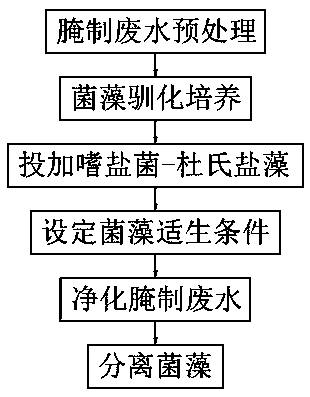Method for treatment of pickling wastewater with dunaliella salina and halophilic bacteria
A technology for pickling wastewater and halophilic bacteria, which is applied in chemical instruments and methods, food industry wastewater treatment, biological water/sewage treatment, etc. low effect
- Summary
- Abstract
- Description
- Claims
- Application Information
AI Technical Summary
Problems solved by technology
Method used
Image
Examples
Embodiment 1
[0026] Adjust the pH of the pickling wastewater to 8.0, filter and clarify, remove suspended particles, and improve the turbidity of the water body; the salinity of the wastewater after pretreatment is 106 g / L, the concentration of total phosphorus is 76.15 mg / L, and the concentration of total nitrogen is 638.24 mg / L, the concentration of ammonia nitrogen is 153.47mg / L;
[0027] Configure bacteria and algae culture medium, which contains the following components in 1 L: 1 g C 6 h 12 o 6 , 100 g NaCl, 0.1 g KNO 3 , 0.1 g NaHCO 3 , 0.01 g CaCl 2 , 0.1 g MgSO 4 ·7H 2 O, 0.1 g KCl, 0.01 g KH 2 PO 4 , 0.001 g Na 2 EDTA·2H 2 O and 0.001 g FeCl 3 ·6H 2 O, the pH of the bacteria and algae culture medium is 8; the bacteria and algae culture medium is mixed with the pretreated waste water of 30% volume percentage concentration to obtain domestication medium A, and the bacteria and algae culture medium is mixed with the pretreatment of volume percentage concentration 80% Af...
Embodiment 2
[0030] Adjust the pH of the pickling wastewater to 7.0, filter and clarify, remove suspended particles, and improve the turbidity of the water body; the salinity of the wastewater after pretreatment is 182 g / L, the concentration of total phosphorus is 79.97 mg / L, and the concentration of total nitrogen is 647.79 mg / L, the ammonia nitrogen concentration is 186.98mg / L.
[0031] Configure bacteria and algae culture medium, which contains the following components in 1 L: 5 g C 6 h 12 o 6 , 180 g NaCl, 0.5 g KNO 3 , 0.5 g NaHCO 3 , 0.05 g CaCl 2 , 0.5 g MgSO 4 ·7H 2 O, 0.5 g KCl, 0.05 g KH 2 PO 4 , 0.005 gNa 2 EDTA·2H 2O and 0.005 g FeCl 3 ·6H 2 O, the pH of the bacteria and algae culture medium is 7; the bacteria and algae culture medium is mixed with the pretreated pickling wastewater with a volume percentage concentration of 40% to obtain the domestication medium C, and the bacteria and algae culture medium is mixed with the volume percentage concentration of 60% fo...
Embodiment 3
[0034] Adjust the pH of the pickling wastewater to 6.0, filter and clarify, remove suspended particles, and improve the turbidity of the water body; the salinity of the wastewater after pretreatment is 243 g / L, the concentration of total phosphorus is 83.15 mg / L, and the concentration of total nitrogen is 657.98 mg / L, the ammonia nitrogen concentration is 196.53mg / L.
[0035] Configure bacteria and algae culture medium, which contains the following components in 1 L: 10 g C 6 h 12 o 6 , 250 g NaCl, 1 g KNO 3 , 1 g NaHCO 3 , 0.1 g CaCl 2 , 1 g MgSO 4 ·7H 2 O, 1 g KCl, 0.1 g KH 2 PO 4 , 0.01 g Na 2 EDTA·2H 2 O and 0.01 g FeCl 3 ·6H 2 O, the pH of the bacteria and algae medium is 6; the bacteria and algae medium is mixed with the pretreated pickling waste water of 30% concentration by volume to obtain domestication medium A, and the bacteria and algae medium is mixed with the pretreatment of 60% concentration by volume After the pickling wastewater was mixed to obta...
PUM
 Login to View More
Login to View More Abstract
Description
Claims
Application Information
 Login to View More
Login to View More - R&D
- Intellectual Property
- Life Sciences
- Materials
- Tech Scout
- Unparalleled Data Quality
- Higher Quality Content
- 60% Fewer Hallucinations
Browse by: Latest US Patents, China's latest patents, Technical Efficacy Thesaurus, Application Domain, Technology Topic, Popular Technical Reports.
© 2025 PatSnap. All rights reserved.Legal|Privacy policy|Modern Slavery Act Transparency Statement|Sitemap|About US| Contact US: help@patsnap.com

